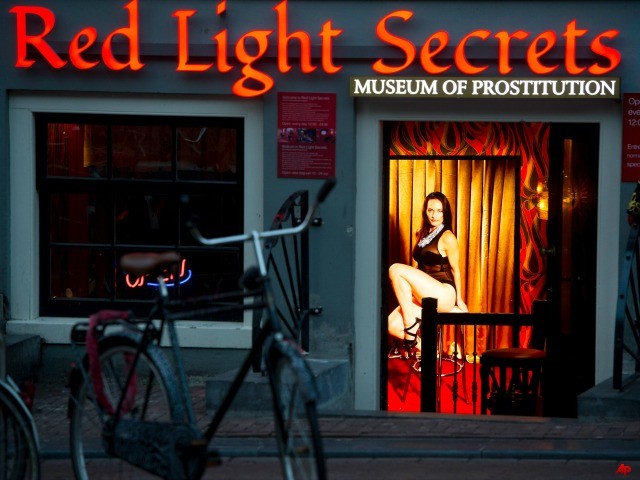AMSTERDAM (AP) — On any given evening, thousands of tourists stroll down the narrow canal-side streets of Amsterdam’s famed Red Light District, gawking at ladies in lingerie who work behind windows, making a living selling sex for money. Now a small educational museum is opening Thursday in the heart of the district to show reality from the other side of the glass.
RED LIGHT SECRETS
Organizer Melcher de Wind says the Red Light Secrets museum is for those who want to learn more about how the area works without actually visiting a prostitute. It’s located in a former brothel, one of the narrow buildings typical of Amsterdam.
Visitors enter the museum by passing a hologram of a beckoning prostitute. Then the displays attempt to place prostitutes as part of society. There’s a short film showing the many people who work with them: those who clean or repair their rooms, do their laundry, or run over to their windows with coffee or food during shifts.
Prostitutes rent windows on a half-day basis and can work shifts that are 11 hours long, six days a week. They spend a lot of time waiting for customers. In their free time, they visit local hairdressers, nail salons and clothing shops.
There’s also a nursery school in the heart of the Red Light District, right next to the windows. In one scene in the film, a middle-aged prostitute in red leather receives an afternoon visit from her grade-school daughter.
A LONG HISTORY IN AMSTERDAM
The museum makes only a passing attempt to document the history of prostitution tolerance in Amsterdam — starting from the 16th century, when it was a port city flush with wealth from the spice trade and authorities turned a blind eye when sailors went ashore looking for women. Or during the Napoleonic Wars, when prostitutes first began to have mandatory medical checkups to combat venereal disease among soldiers.
The museum focuses on the era since 2000, when prostitution became legal in the Netherlands. Since then the city has been struggling — it says with some success — to eradicate pimps and human trafficking.
Yolanda van Doeveren, who manages the city’s prostitution social programs, says the district is regulated by police officers, social workers, health workers, tax authorities and civil rights groups. A new girl who appears in a window will be noticed in a matter of hours and must be able to show that she’s old enough and has approval to work.
The legal age to work as a prostitute in Amsterdam has recently been raised from 18 to 21.
Van Doeveren says trafficking remains at the heart of the Dutch debate over the ethics of prostitution. There’s also an acknowledgement, however, that the worst abuses of underage girls or prostitutes being exploited by pimps now take place out of sight in underground brothels — an ongoing challenge for police.
IN THE WINDOW
At the museum, the tour resumes: In one hallway, there’s a work roster on a white board showing who’s working in which room on what days, along with times for client appointments. There’s also a chance to take a seat in an actual window in front of passers-by.
And then the tour proceeds to a typical “peeskamer,” Dutch for “workroom.”
Ilonka Stakelborough, an escort who heads a sex-workers union called “the Geisha Institute,” says the rooms, about nine feet long and six feet wide (3×2 meters) have a standardized look that could really use an update — black lights have been nearly universal since the 1970s.
The beds are low and strong, near a sink and a small cabinet of lubricants, cleansers, condoms and sex toys.
“No perfume,” Stakelborough says. “Because then the smell rubs off on a man’s clothes and he has problems with his wife when he gets home.”
Are married men the main customers? No, you can’t generalize, Stakelborough says. Men of all types, married, unmarried, young or old visit prostitutes at all hours, she says — some even on their way to work in the morning.
How do you know who’s just coming to look and who wants to do business?
“Eye contact,” she said.
THE PROSTITUTES THEMSELVES
Very few women who work as prostitutes ever earn more than a middle class income at best — and usually it’s worse, according to Stakelborough and Van Doeveren.
Stakelborough says it’s not the prettiest or youngest girls who get the most customers or earn the most. And escorts and high-end brothel prostitutes don’t necessarily do better — they have fewer customers, longer sessions and lots of costs, for taxis or splitting profits with brothel owners, she said.
A window typically rents for 150 euros ($202) for a half-day. Given the standard cost of about 50 euros ($70) for a 15-minute session, their take-home pay before taxes is only 150 euros after seeing six clients, or 250 euros ($338) after eight.
Approximately 75 percent of the women are from poorer countries, often Romania or Bulgaria.
“Almost all the women who are here are here ‘voluntarily’, in the sense that they come knowing what they’re going to do,” van Doeveren says. “But you can ask yourself what their other options were.”
At the end of the museum there’s a wall of quotes from prostitutes.
“This job is not for the faint-hearted,” wrote Eva from Holland. “I have become much harder.”
“It makes me feel lonely my mother doesn’t know what I do,” wrote Carmen from Romania.
Visitors can write down their own sexual secrets in a mock-up confessional booth before heading back out onto the street.
_____
If you go:
The “Red Light Secrets” Museum of Prostitution is located on the Oudezijds Achterburgwal 60-62 in Amsterdam. The museum is open daily from noon to midnight.
Admission cost: 7.50 euros.

COMMENTS
Please let us know if you're having issues with commenting.